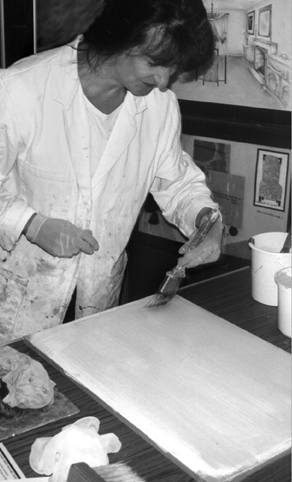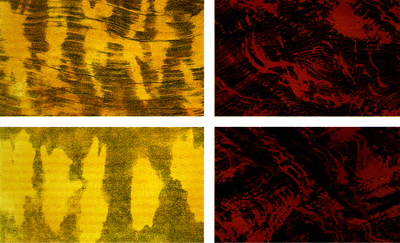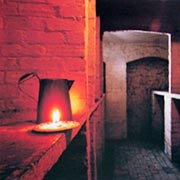Painting and decoration
‘Graining, like diamonds in a portrait painting, should be sparingly employed, for its scarcity constitutes in a great measure its value.'
- T H Vanherman, 'Every Man His Own House Painter', 1829
The two main ingredients in paint used during the Regency period were white lead, which was the colour base, and linseed oil, which had preservative and weather proofing qualities. Both of these had their drawbacks - linseed oil had a tendency to turn yellow, and white lead was toxic - but their use continued because it was felt that there were no suitable alternatives.
 A wide variety of painting techniques were employed in the decorateing of Regency home interiors. For example, ‘clear coaling', or glazing on a white background (the term is derived from the French colle, meaning glue or size). In clear coaling, a preparation of whiting and size formed the base coat, and this was finished with a translucent top coat of oil colour prepared with lead.
A wide variety of painting techniques were employed in the decorateing of Regency home interiors. For example, ‘clear coaling', or glazing on a white background (the term is derived from the French colle, meaning glue or size). In clear coaling, a preparation of whiting and size formed the base coat, and this was finished with a translucent top coat of oil colour prepared with lead.
The techniques of graining and marbling were also extremely popular in the early nineteenth century. They were used to decorate woodwork - doors, shutters, wainscoting - walls, and furniture. In 1827, Nathaniel Whittock wrote in his Decorative Painter's and Glazier's Guide of ‘the art of imitating the grain and colour of various fancy woods and marbles', and commented that ‘there are few respectable houses erected, where the talent of the decorative painter is not called into action'.
In Smith's Art of House Painting, published in 1821, William Butcher described how graining in imitation of mahogany was produced: ‘first coat, white lead; second coat orange (with orange lead); then finished with burnt terra de Sienna, with a flat brush waving and imitating the veins as they run in any fine piece of mahogany'.

Above: Examples of graining.
Even the outside of the house exhibited specialised paint finishes. Busby specified that the softwood front doors and windows of his Brunswick houses should be decorated with a grained finish imitating oak. Marbling was often used on walls in the hall and stair areas. The source of this inspiration was the Regency love of antiquity where the marble of classical Italy was copied to create an antique look in new British homes. Bronzing was achieved through the use of dark green paint and bronzing powders to create an aged effect. These techniques were used to decorate doors, shutters, wainscoting, and furniture.
Today we see the windows and doors of the homes in Brunswick Town painted in flat colour, in the 1830s however, these pine joinery items were decorated with a grained finish in imitation of oak.
If you are interested in further reading on this topic, these links will provide you with more information:
Solvent Free Paint; History of linseed paint
Public book shelf; History of paint
Painting a house during the regency era: Q&A with Patrick Baty
Georgian paint, Victorian paint and Edwardian paint on Freepedia
Brief history of woodgraining and marbling



